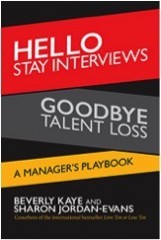 Employees are not a replaceable commodity. According to recent research, the tide has turned and employee retention has become a critical issue for organizations.
Employees are not a replaceable commodity. According to recent research, the tide has turned and employee retention has become a critical issue for organizations.
One of the easiest and most effective ways keep top talent is through “stay interviews,” developed by Bev Kaye and Sharon Jordan-Evans. First described in their bestseller, Love ‘Em or Lose ‘Em, they have fleshed out how this works in their new book Hello Stay Interviews; Goodbye Talent Loss.
What I particularly like about this approach is it puts the responsibility for retention in the hands of the people who are in the best position to make a difference – the direct managers. And it is something managers can easily incorporate into their job.
I had the privilege of catching up with Sharon Jordan-Evans last week and learning more about how stay interviews work.
Jesse: What are “stay interviews” and why do they make a difference?
Sharon: Stay interviews are one-on-one conversations that managers (at any level) have with talented employees to find out what might keep them on the team and then together figure out a way to implement it.
Just asking the question goes a long way. It encourages them to stay because they feel highly valued. Managers can quit guessing what their talented people really want (is it money? promotion? flexible work schedule?). And once they get the real scoop, managers can partner with their talent to creatively help them get more of what they really want, right where they are.
Here’s how they work. Picture this – you’re someone I can’t afford to lose. It’s as simple as this: I call you in and tell you how important you are to me and to the team. Then I ask you what would keep you here and what could entice you way.
Jesse: That sounds simple, but what if they request something you can’t deliver?
Sharon: We describe a simple four-step process for dealing with hard-to-deliver-on requests. Here’s an example on how it works.
My direct report, Darrel, replies to my question, “What will keep you here?” with the dreaded response, “A 20% raise would do it.”
I respond to his request, using the four steps:
1. Acknowledge how much he matters to you and the team: “Darrel, you are worth that and more to me.”
2. Tell the truth about obstacles you face: “I’d like to say yes, but I will need to investigate the possibility. I’m honestly not sure what I can do immediately, given some recent budget cuts.”
3. Care enough to look into the request: “But I hear your request. I’ll talk with Human Resources and my manager about it and get back to you by next Friday with some answers and a possible timeline for a raise.”
4. Ask “What else?” “Meanwhile, what else matters to you? What else are you hoping for?”
(Keep asking “what else” until Darrel gives you something you can work with, such as a new learning opportunity or a chance to mentor or be mentored.)
Managers worry about opening a Pandora’s Box when they ask a treasured employee what will keep him or her. But as long as you use these four steps, you’ll be fine. And remember, not asking these questions and not stating how important an employee is to you and the team is far riskier than conducting stay interviews.
Jesse: Are there any other important guidelines?
Sharon: Just two.
First, managers need to be authentic. If you don’t really care about the employee or whether he stays or goes, do NOT conduct a stay interview. Consider having a performance conversation instead to help him develop into an employee you cannot afford to lose.
Second, this is not a “once and done” kind of thing. Stay interviews need to be ongoing and woven into the way you manage.
About Hello Stay Interviews; Goodbye Talent Loss by Beverly Kaye and Sharon Jordan-Evans
Good employees are hard to find, and they can be easy to lose. But there’s a simple tool every manager can use to ensure that star performers and solid contributors alike will feel energized, engaged, and excited—and that they will give you fair warning if they’re unhappy. It’s called the stay interview, and this book is the manager’s definitive guide, written by the women who created the concept. They explain how to create an atmosphere that will make the interview more comfortable and provide dozens of suggested questions and icebreakers, as well as tips for easing any performance anxiety you might feel. Think you don’t have time? They offer all kinds of options for where, when, and how you can do stay interviews, from folding them into other business processes to doing them casually, like on a walk to get a cup of coffee. Stay interviews prevent exit interviews!
Click here to learn more or download the first two chapters.














I love this idea of stay interviews.. Beats Exit interviews!!
Indeed. Stay interviews prevent exit interviews. Thanks, Calla!
I still wonder how many managers will want to adopt this method, most of them will feel they are making the employee to feel indispensable. But I think its better to do that than to risk losing the employee. Hence one has to adopt these four steps outlined here to stay safe. Thanks for writing this.